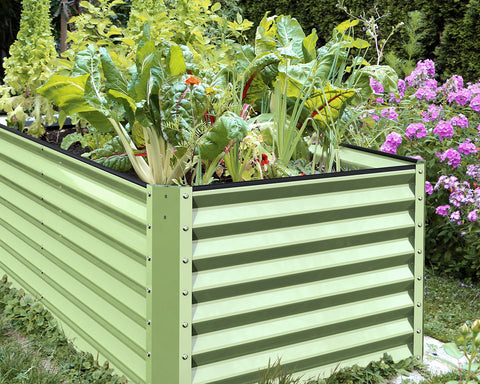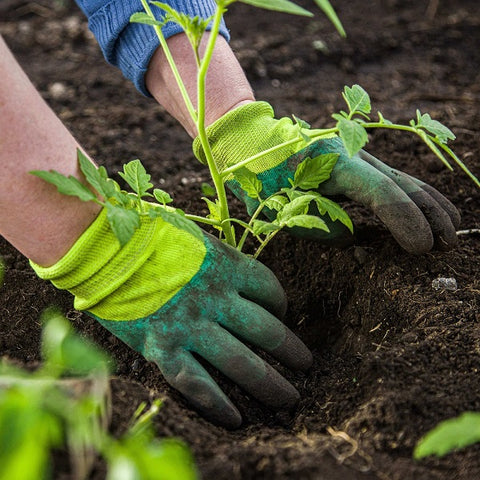Now is the end of winter and the beginning of spring. In most areas, people are preparing gardens for spring planting. But what does it take to prepare the spring garden? What specific steps should you take each year? The following content also has some reference value for raised garden beds.
Whether you are new or old, you may find something on this list that makes you "Oh, yes, I need to do this". So here is a quick list of what you should do to make everything in order before you start planting your garden in spring!

Prepare your equipment
I know, it seems strange, but before you start working in the garden, you need to prepare your equipment. After all, if your tools are not ready, you can't finish the work, right?
Before leaving and handling the soil, ensure that all tools have been thoroughly cleaned and disinfected. Although most people may roughly clean tools before storing them in winter, any residual plant sap, dirt and debris may contain bacterial or fungal spores.
So before you take out the pruning pliers to trim the branches, take some time to thoroughly disinfect your tools. You may remove most of the dirt before putting them away, but soaking them in a solution of 10% bleach and 90% water for about half an hour can kill any soil pathogens that may still exist.
Other things that have good disinfection effects on tools include Pine Sol (again, let your tools soak well in dilute solution) and liquid Lysol detergent. These three can kill bacterial infections and remove residual fungal spores, but I prefer to use bleach because it is cheap and can be seen everywhere.
Once you disinfect your tools, be sure to wash off all residual bleach with clean water. Then, you can dip the tool between the wounds in the same way, so you won't spread the disease. Be sure to clean and flush the tools at the end of the day, because the residual bleach will slowly corrode the tools.
Apply a good layer of oil between use to prevent tools from rusting.
This is also a good time to polish any necessary tools. Your pruner and lawnmower may need to be polished well, but your lawnmower blade is often forgotten in the process. Shovels may also need to be slightly sharpened, especially if they have a sharp tip to cut into the soil.
If your lawn mower is a gasoline engine, you want to empty the fuel tank before storage in winter to ensure that the carburetor is clean. But if not, please replace the gasoline in the mower.
In addition, check the carburetor to ensure that there is no problem. This time of year is a good time to repair the mower, just to ensure that the mower is in good condition to adapt to the rapid growth you are about to experience in spring.
Finally, it's time to clean up your greenhouse! Your greenhouse needs to be thoroughly cleaned before all your seedlings can grow. It may be cold outside, but you won't have to do it again. Remove the old debris, clean the shelves, remove the residual soil, and clean the surface so that the light can easily penetrate.
Once your tools are set up, it's time to start real work!
Weed and pest management
The weeks before planting anything is the time to prepare for the growth of the next year.
Early spring is an ideal time to add soil nutrients, ensure that the soil is not compacted and remove any weeds. Many people also choose to cultivate at this time of the year (although if you use no-tillage method, you can skip this step).
First, remove the weeds that appear. When you think of the word "spring", weeds have a way of spontaneous outbreak. You will find them almost every year.
Before they begin to sow, take them out and start a problem for you for many years! I personally like to pull them out of their roots, so they have no chance to grow again and continue to spread.
If you had a caterpillar problem last year, you need to make sure that all your garden beds are thoroughly weeded, and then turn over the top 6-8 inches of soil. You will be able to find any hidden pests, winter in your bed in this way, and remove them.
This is especially true if you encounter problems with earthworms. As earthworms are one of the earliest pests in spring, they will attack your seedlings, so you don't want to take the risk that they have appeared.

Check your soil
In spring, you can also bury the mulch crops in the soil and give them a few weeks to decompose before planting. Cover crops provide a lot of nutrition for young plants.
Do a soil test and pH test at this time of year to see what your garden bed needs. You can send soil samples to the local ag extension, or purchase a commercial test option. This is mainly to give yourself a concept that needs to go deep underground.
The compacted soil needs to be loose to provide air flow and make the young roots easy to grow. There are many ways to loosen the soil. If necessary, you can use modifiers such as perlite, which will help provide corners and cracks in the soil to facilitate air circulation.
Simply adding some organic substances will also provide sufficient air and water retention potential, so this is a good time to put compost into the soil.
It may be necessary to cover the raised bed with more soil. This doesn't seem to be a problem when you install your mobile bed for the first time. After all, you may have put a ton of earth in it!
But in the next few years, you will notice that your soil will be significantly reduced. This is the best time of year to add more materials and mix them with existing soil. Make sure that the soil you add is clean, free of weeds and seeds, and sterile.
Finally, it is time to fertilize. Does your soil test tell you that you need more nitrogen? Is the potassium content low?
Decide what fertilizer you need according to the plants you want to put there. Different plants have different needs. Tomatoes are rich in calcium, which can prevent the flowering end from rotting. Your pansies and petunias may need phosphorus to bloom.
The first few weeks of planting are beneficial to the selection of most organic fertilizers, because it gives time for nutrients to spread in the surrounding soil. However, you can also use slow-release granular fertilizer at this time of year to increase nutrition in the long term.
If you want to sow directly on your bed, you don't want to cover it, so that young plants can sprout. However, if you want to transplant, after you prepare the soil, cover it. A thick layer of mulch can protect your prepared soil from weeds, seeds and other problems.
Those of us who directly sow seeds may want to spread a piece of landscape fabric on the soil surface and fix it in a proper place to prevent weeds from breeding, while we focus on other things.
Check the irrigation system
This is the time of the year to check whether the irrigation system leaks and whether the spray distribution is good. If you are using a ground system, replace any damaged hoses or drip marks at this time. Once the ground thaws, the pipeline will not freeze, please check immediately.
Add a compost pile
Spring is also an ideal season to add long-term garden features. If you haven't developed a compost pile yet, it is time to add a compost pile, even if it is as simple as a compost cup. You will find a lot of green garbage. Why not turn them into fertile soil? Now it is also a good choice to build a potted platform.
Repair the fence
Catch the vines before they take over. Does your neighbor have a vine that will devour your fence in summer? If you catch it in the spring before it is established, you can prevent it from controlling it.
Therefore, it is a good idea to repair the fence at this time of year. This is a good time to re-fix those loose boards or replace those bent under the weight of snow or ice. The ground is soft, so if you need to replace an old fence, catch those diggers and go!

Plan a planting schedule
Most of us have developed a spring garden so that we can plant everything. But it needs a little planning to decide what to plant first and when to start the next stage of planting.
February to March is the season for planting a variety of fruit trees in California. Tomatoes need to be sown in April to get the best yield. But it was California... not everyone left their winter wonderland.
If you haven't already done so, study your plant selection. Look at your standard weather pattern and decide when to plant trees, shrubs, flowers and vegetables. There are a thousand guides written by gardening masters, which can tell you exactly when to plant specific plants for your area.
Although I like to make my plan in winter so that I know when I need to do everything, you can start this step at any time. This year is still early, you can still have a dreamlike garden!
The edible plants in the spring garden include lettuce, spinach, a variety of onions, short-season leeks, peas, and almost any other plants that like to grow at temperatures between 40 and 70 degrees. This is also the time to plant peaches, plums, nectarines and other summer fruits, so that they can start planting before the summer heat comes.
In areas where grapes grow well, spring is the time to start new vines so that they can be established. Curry should also start in spring. It is ideal to start planting perennial plants like asparagus now!
Don't forget your spring bulbs, such as water lilies and tulips, or early flowering plants that provide a lot of color and growth for your garden. At this time, we should plant bearded iris, crocus, and even bleeding heart.
Deep winter and early spring are also the best time to start germination, so they are good sizes for future planting. Other summer plants, such as zucchini, can also be planted immediately to provide a good start for future transplantation.
There seems to be an endless series of things to do in spring, but a few years later, all of these have become second nature. When we move towards spring, take these simple steps to make your garden the best start of the year, which will help it grow!









